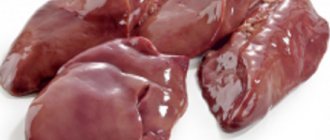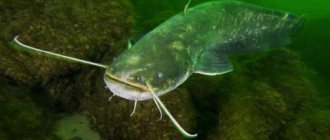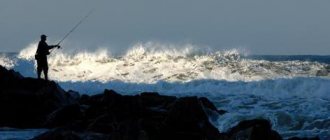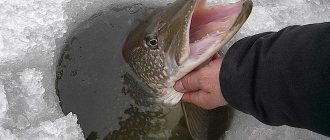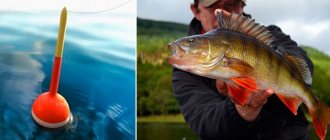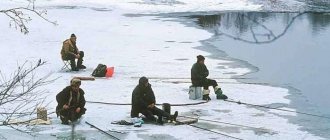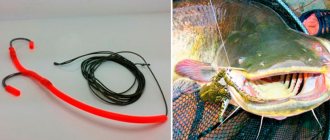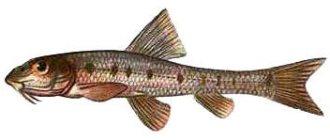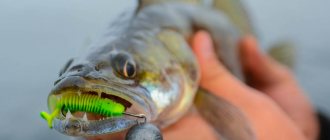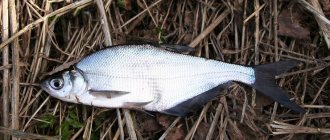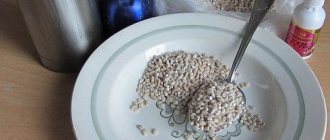Species composition of ichthyofauna
Fishing on Akhtuba is interesting because the waters of this river are home to many different species of fish. It is difficult to predict in advance which representative of the ichthyofauna will be on the hook after the next bite. The main trophies of anglers are:
- crucian carp;
- carp;
- bream;
- roach;
- catfish;
- zander;
- pike;
- perch;
- asp;
- chub;
- White amur;
- rudd;
- silver bream;
- tench;
- carp;
- vobla;
- silver carp;
- saberfish;
- ide;
- buffalo.
Reference! At the beginning of summer, Caspian herring enters the river and actively bites on various amateur gear. Occasionally you come across sturgeon fish listed in the Red Book.
Spring fishing on Akhtuba
Spring in the Astrakhan region begins very early. At the beginning of March, areas of open water appear on Akhtuba, and by the 20th the river is completely free of ice. It has been noticed that the predator’s bite is more intense if the ice melts late.
March weather is unstable: temperatures range from -3°C in the morning to +18°C at noon. At the same time, in the middle of the day a cloud may fly in and cover you with wet snow.
The fish bite depends to a large extent on the temperature and water level, which, in turn, is influenced by the operation of the Volgograd hydroelectric station. It is believed that a good bite begins at a water temperature of +6-8°C, but sometimes on a fine day an active predator bite is observed at only +3-4°C.
There is good fishing on Akhtuba in the spring in lakes and eriks, but due to the impassable mud and loose roads at this time of year, getting to them is not easy. The coolest days come from the moment when the floodplain dries up and it becomes possible to get to the lakes by car. At this time, pike bites are especially greedy, literally tearing the spinning rod out of your hands. On the river, the bite of a predator that has recovered from its winter torpor is not spoiled even by a sudden cold snap. But in lakes, windy weather can muddy the water and ruin fishing.
Pike and pike perch become more active after the ice melts. Pike perch stays near wintering pits at a depth of 5-7 m. From the shore they practice jig fishing, from a boat they “jig” in the pits or catch by trolling. In March, pike perch is not very nimble and attacks the bait from a minimum distance from an ambush. It is well caught with live bait, both from a boat and from the shore.
Pike begin their active pre-spawning feeding in March. It is well caught using live bait and artificial baits using a spinning rod (they are selected small in size, since pike in March are not tempted by large prey).
The perch bite only intensifies as the ice melts. It is caught with live bait in small areas, where it is attracted by small fish and insect larvae.
In April, the water quickly warms up, this causes rapid reproduction of the food supply and the activity of hungry peaceful fish. And although restrictions on fishing have been introduced since April 20, this fishing period is the most impressive.
White fish bite well: bream, roach, bluefish and silver bream. In warm shallow waters, rudd is caught, moving in the evening to the lower warm layers; in the algae thickets, silver carp and tench are caught. The following gear is used: wire and Bolognese fishing rods, donka, feeder, and as bait - worms, bloodworms, maggots, shell meat, insect larvae. There are carp, crucian carp and buffalo.
Since mid-April, giant Akhtuba catfish have been caught in deep-water channel pits. It goes for any bait and lure. But the gear must be appropriate. To fish out a giant weighing half a centner, you will have to work hard.
Most fish species spawn in May, and fishing in spawning areas and channels is prohibited. However, you can fish from the shore at some bases. You should focus on catching peaceful fish for which the spawning period has not yet begun: silver and gold crucian carp, bream, silver carp, buffalo, rudd, etc. A worm, maggot, and shell are used as bait. The predator's bite from the shore using live bait or spinning rods is not as intense as in April, but quite impressive.
Seasonal fishing features
When going fishing in the Volga-Akhtuba floodplain, you must take into account the seasonal characteristics of fishing. This will allow you to focus on fishing for specific species of underwater inhabitants and choose the right gear, bait and lures.
Spring
The river is completely free of ice cover in the last days of March. After this, very interesting fishing for a variety of fish begins, which continues until April 20. Next, there comes a two-month ban on fishing associated with spawning processes. In early spring they bite well:
- zander;
- pike;
- perch;
- asp;
- ide;
- catfish;
- chub;
- roach;
- vobla;
- silver bream
After the ice melts, the pike perch remains at the winter points for some time. During this period, you should not look for it near the river bed itself. At the end of March and beginning of April, the “fanged one” prefers to stand in deep holes with a slow flow, at the bottom of which there are snags.
Many spinning anglers come to Akhtuba specifically to catch trophy pike perch.
At this time, it is caught with spinning tackle, using small vibrotails and natural-colored twisters as bait. In order for the wiring to be of high quality, the weight of the jig head must be at least 40 g.
On a note! After the mass entry of roaches into Akhtuba, which usually occurs from April 5 to 15, the pike perch leaves their winter camps and enters smaller areas. At a depth of up to 4 m, it is successfully caught not only with a jig, but also with wobblers.
Immediately after the ice melts on Akhtuba you can catch good pike. In cold water, the toothy predator, like pike perch, stands in fairly deep areas with no current. She lies in wait for her prey in holes under steep banks. Here it can be provoked to bite using the following types of bait:
- foam fish;
- bright vibrotail about 15 cm long;
- pretty big twisters.
After eating for about a week, the pike goes to spawn, and its biting stops until about mid-April. After spawning, it is mainly caught in eriks, using various spoons and shallow-water wobblers as bait.
Perch begins to bite a week after the ice cover disappears. Smaller individuals feed on shallow water spits, where the depth does not exceed a meter mark. More respectable specimens hunt on edges located at a considerable distance from the shore. In the spring, the Akhtuba striped fish responds better to the following baits:
- bright twisters 5–7 cm long;
- small vibrating tails;
- crank wobblers with a depth of 1–3 m;
- tile spinners.
Towards mid-April, perch en masse enters the well-warmed water of small eriks, where at this time a lot of fry gather.
From the first days of April on Akhtuba you can catch asp very well. In the spring, this predator does not create noisy “cauldrons”, as happens in the summer. It hunts in bottom layers of water and responds well not only to traditional castmasters and Devons, but also to deep-sea wobblers. Topwaters practically do not work during this period. Excellent places for catching sheresper in April are located below the ferry located near the village of Selitrennoye.
Akhtuba is one of the best places for those who want to catch large catfish.
In the spring, ide becomes a frequent prey for beavers and feeders. It feeds at a depth of about 2 m and prefers to peck on worms and maggots. The largest specimens are caught on jig spinning baits.
On a note! In early April, catching large catfish is quite problematic, but small individuals regularly take twisters and vibrotails intended for pike and pike perch. “Mustachioed” bites also often happen on bottom tackle if a bunch of worms are used as bait.
Towards mid-April, when the first insects appear in the air, the chub begins to become active. Throughout the daylight hours, this predator willingly attacks various artificial baits:
- small crank wobblers imitating beetles;
- “pinwheels” of dark color No. 0–1;
- small twisters;
- miniature Devons.
Most of the bites occur under steep banks. Increased fish activity is observed in calm, sunny weather.
Almost immediately after the ice melts on Akhtuba, interesting roach fishing begins. In spring, this species bites well on various fishing gear:
- fly float rod;
- Bolognese tackle;
- feeder;
- classic donka.
A particularly large concentration of this species is observed in eriks and bays. The most versatile bait is a dung worm. Together with roach, silver bream is often caught on the hook.
In early April, roach enters the river en masse. During this period, you can always see a huge number of anglerfish on the banks of Akhtuba. The fish preparing for spawning are not at all picky and greedily grab any bait. Even the roughness of the gear that the aborigines use does not bother her. Active biting lasts about two weeks.
What gear to take to Akhtuba
On Akhtuba, depending on the choice of trophy, you will need various spinning tackle: medium class, for catching medium-sized catfish, pike, pike perch, asp, light class, for perch, rudd, saberfish, donkey for carp, medium-sized catfish, or powerful tackle for trophy catfish fishing .
We advise anglers to take with them a float rod, a match rod for long casting and a medium-power feeder. When going to Akhtuba for the first time, every angler would like to know in advance what tackle, bait and equipment he will need on his trip. You don’t want to carry too much with you or feel out of place when you come fishing with gear that is completely unsuitable for the conditions of the region. Som
To catch medium-sized (up to 20-30 kg) catfish with a spinning rod or donkey, you will need medium-power tackle. A spinning rod should be 2.5-2.7 m long with a weight in the range from 10 (15) to 50 (80) g. Since a rod of this class is also suitable for catching other predators, you don’t have to take a lot of rods with you. An example of a multi-purpose fishing rod is the AVS-105 or Whisker from DAIWA. With such gear, catfish can be caught both with a spinning rod and a donkey.
To catch catfish you will need a powerful reel. The suitable size of a spinning reel is 3500-4500. The Ambassador or Penn multiplier is a more powerful and compact reel than a spinning reel. The fishing line can be used either “mono” (0.4-0.6 mm in diameter) or “braided” 0.25-0.35 mm.
For bottom fishing you will need sliding sinkers from 50 to 80 (100) g, swivels, leashes and, of course, sharp and durable single VMC or Owner hooks.
The most commonly used baits for spinning fishing are jigs: vibrotails and twisters 9-11 cm in size, bright yellow, white, poisonous green, rigs with live bait or dead fish. The weight of the jig head ranges from 18 to 40-60 g, depending on the depth and strength of the current at the fishing site. For small things, it’s worth taking strong swivels, fasteners, and leashes.
The largest catfish in the last ten years was caught on a bottom bait, the bait was a kilogram sabrefish - the most delicious bait for catfish. It happened at the end of October on Gerasimovka, a channel connecting the Volga with Akhtuba, 12 km from the village of Bolkhuny. The monster grabbed the bait at sunset, and they defeated it only at five o’clock in the morning. The catfish weighed 186 kg, length 3 meters 46 centimeters. Of course, such giants are a huge rarity, but even a 50-kilogram catfish caught on a lure will be remembered for a long time. A strong, hardy fish is capable of tirelessly dragging a boat with a fisherman along the Akhtuba reaches for a couple of hours.
Zander
Pike perch is caught with a spinning rod, and therefore you will need a rod 2.4-3 m long with a test weight in the range from 5(7) to 30(40) g, a spinning reel or a medium-power multiplier of your choice, braided fishing line with a diameter of 0.18-0, 22 mm.
Lures - vibrating tails, twisters, foam rubber fish of bright colors weighing a weight head from 16 to 35 g, rotating spoons, both with a central weight and with a weight-head, deep-diving wobblers like Deep Runner, also in bright colors, just in case, sheer spoons like Pilker .
Asp
To catch asp, you need a spinning rod with a length of 2.4-3 m, a test weight in the range from 5 (7) to 30 (40) g, a spinning reel, size 2500-3000 with a high gear ratio (at least 5.2/1) , braided fishing line with a diameter of 0.15-0.2 mm. or can be 0.25-0.28 mm
Lures: rotating spinners Aglia Long, Blue Fox, Myran (No. 1-4), oscillating spinners Castmaster, Koster, “Atom”, “Storling” or similar, floating wobblers 5-9 cm in size, Devons, flies, streamers.
Pike
To catch pike you will need a spinning rod 2.4-3 m long with a test weight in the range from 5 (7) to 30 (40) g, a spinning reel (size 3000-3500) or a medium power multiplier of your choice, braided fishing line with a diameter of 0. 18-0.26 mm.
Lures: large rotating spinners Blue Fox, Merrs (No. 4, No. 6), large but light (fishing takes place at shallow depths), oscillating spoons Kuuasamo, ABU, domestic “Storling”, “Norich” and similar ones. Some spinners need to be equipped with non-snacking equipment. You will also need large floating wobblers and poppers.
Carp
Rod for fishing from a boat. The length of the rod is 2.1-2.4 m with a test weight of up to 100 - 150 g. It can be made of carbon fiber, composite or fiberglass, depending on how much you decide to spend on purchasing it.
Inertia-free reel (size 3500-4500), multiplier or “Nevskaya” - at your choice, mono line with a diameter of 0.35-0.60 mm or braided 0.30-0.40 mm, sliding weights weighing 80-150 g, hooks carp for fishing with corn, boilies, cake, shell, spacious landing net.
Perch
Lightweight spinning rod 2.1-2.4 m long with dough from 3(5) to 10(20) g, spinning reel (size 2000-2500), mono line 0.15-0.2 mm or braided with a diameter of 0.08 -0.10 mm.
Lures: Blue Fox, Muran, Merrs No. 1-3. Medium-sized “oscillators”, small wobblers, twisters and vibrotails with a head weight from 4 to 10-15 g.
Fishing in the upper reaches of the river
Verkhnyaya Akhtuba is the name given to the section from the state district power station located in Volgograd to Akhtubinsk. The proximity of a big city has a negative impact on the river's fish resources. In the vicinity of the metropolis, catching a trophy specimen is quite difficult. Luck favors only those anglers who know the bottom topography well and have a boat with a powerful engine that allows them to quickly change promising points.
Good places for coastal fishing are located near the bridge in the city of Leninsk, where you can catch perch and pike perch with a spinning rod, and bream and roach with a feeder. On Staraya Akhtuba you often come across trophy specimens of pike.
The worm is the most universal bait for fishing white fish on Akhtuba.
It is better for anglers planning to travel to these regions to go to an area located 50–70 km below the state district power station. Fishing in the Akhtubinsky district will be much more productive than in the Volgograd region. Here you can successfully catch both predatory and peaceful representatives of the ichthyofauna.
In Akhtubinsk
The Akhtuba River flows along the outskirts of the village of Akhtubinsk, so you can always meet people with fishing rods on the city embankment. In the spring, those who like to fish for a variety of fish gather here. Starting in April there is a chance to catch:
- roach;
- silver bream;
- ide;
- chub;
- roach.
Fishing, as a rule, is carried out with Bolognese fishing rods or bottom gear. The traditional bait is a worm.
After the end of the spawning ban, various predators begin to peck from the embankment. The trophies of urban spinning players are often:
- perch;
- zander;
- catfish;
- saberfish;
- asp.
On a note! Night fishing for pike perch is especially interesting and productive. In the dark, the “fanged” one is successfully fished using small natural-colored wobblers with a depth of about 1 m. The predator hunts in the coastal zone, so long casting is not required.
Recreation centers
Most anglers go to Akhtuba as a “savage”, but there are also those who prefer comfortable fishing at recreation centers, of which there are quite a few on the river.
"Barn Batu"
In the vicinity of the Sarai Batu base there are many creeks, pits and sand spits. Thus, ideal places are created here for fishing a wide variety of fish. By renting a motor boat or speedboat in the nearby water area, you can catch trophy catfish, pike perch and asp.
The cost of a room in a wooden house ranges from 800 to 3 thousand rubles per day. Experienced rangers at the base will help you collect suitable gear and deliver it to the most promising points.
"Akhtuba"
The base is located on the left bank of the Akhtuba River, near the settlements of Sasykoli and Bugor. On its territory there are:
- restaurant;
- Russian bath;
- gazebos;
- parking.
A large fleet of rowing and motor boats is available for vacationers. Here you can rent equipment and fishing gear. The price of accommodation in the houses ranges from 2 to 7 thousand rubles per day. Camping will cost 600 rubles.
"House on Trekhrechye"
“House on Trekhrechye” belongs to economy class recreation centers. It is located at the confluence of Akhtuba with the Ashuluk and Mangut rivers. The nearby water area is famous for catching large carp and catfish.
Reasonable prices and good living conditions have made this base one of the most popular. Renting a house will cost only 450 rubles/day, and there are discounts for children and WWII.
Sudach places on the map of Three Rivers.
Anglers who want to save money can rent a house in the private sector of the village of Selitrennoye, which will cost approximately 350 rubles per day. Local residents willingly rent out not only residential premises, but also watercraft.
Despite the fact that Akhtuba’s fish stocks have been greatly depleted over the past decade, this river still remains a real Mecca for anglers who want to catch their trophy.
Victor Andreev: AKHTUBINSKY RAZDOLE
Akhtuba - this word has a magical effect on our brother fisherman. Even if someone has not been here yet, he has heard plenty of fishermen’s stories about local abundance, so sooner or later he will definitely visit these fertile lands.
Photo 1. Pit Zamanikha – the name alone is worth it!
Indeed, Akhtuba is a haven for fishermen and especially for spinners. It’s enough just to see the local shores, completely dotted with tents and entire camps with fires and smokehouses, filled with different-sized fishing rods, donks and kukans... And in the most fishing places there is literally “no crowding”: everything is occupied by boats - from simple “inflatables” to sea boats. And they catch everyone! At the same time, there is complete democracy - whoever is given a record catfish, and whoever is happy with any fish!
There are also many fishing bases on Akhtuba. And this is natural: the fewer everyday problems, the more time you can devote to fishing. At one of these bases with the most appropriate name “Razdolie” I managed to spend ten wonderful August days.
Photo 2. Base “Razdolie”
